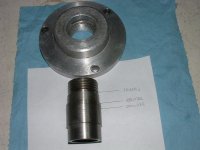It is highly unlikely and unwise to re-thread a lathe spindle as you have on the old LeBlond lathe. Chances are the spindle nose & thread are hardened and ground. Assuming you could cut the spindle with a tool bit, you stand a chance of winding up with a thread and register (un threaded portion) that are not as accurate as the original spindle thread and register diameter (un threaded section of the spindle nose which the chuck plate has a close fit with). Leave well enough alone. Make up the back plates you need. My own method- I have a 13" LeBlond Roundhead Regal lathe with 2 1/8"-5 spindle nose thread- was to make up a male gauge or "dummy spindle" by turning and cutting the spindle thread on a piece of round stock. This is made to the same depth of thread as the spindle thread and same register diameter. I have a male threaded gauge (or dummy spindle) which I can try in any backplates I am making up, without having to break the setup or having to "pick up the thread" again with the thread cutting tool. It lets me skim or take spring cuts and get just the right fit on the backplates.
If you feel confident in thinking about rethreading the spindle nose, then you should apply that same line of thinking to making the dummy spindle and then making up some back plates. New backplates for these older lathes with threaded spindle noses do not exist unless they are something popular like a South Bend Lathe. Lathe manufacturers never had any standardized spindle nose threads, and each often used their own design. Example is Seneca Falls lathes: they used something like 10 threads to the inch vs the 8 threads to the inch used by South Bend and Logan. LeBlond had their own ideas as well. If you want to own and use an older lathe like your LeBlond, the reality is that you must be prepared to make things like chuck back plates from scratch. LeBlond was quite thoughtful in this regard, and included a 5 threads/inch slot on their quick change boxes.
If you do not have a spare faceplate or dog plate to use as a female gauge when you turn the male gauge (dummy spindle), then you will have to measure the spindle thread on your lathe using the "three wire" method- Machinery's Handbook has tables as to diameters of wires (actually you will likely use pieces of drill rod that are cut from a length of "number sized drill rod rather than real wires). When you have the depth of thread established, you will need to grind a threading tool bit with the correct (or approximate) helix angle on the nose of the tool. Again, Machinery's Handbook will help you calculate this angle. Once you have the depth of thread and the threading tool bit ground, you can make your dummy spindle. Some calculations and some care in cutting the thread on the male gauge and you will have a dummy spindle. It can be kept for making as many back plates in the future as needed. The backplates are a whole other matter. I've made some out of steel, using A-36 (structural grade, hot rolled) plate and bar stock. Depending on the size of backplate you need, Shars or Grizzly may have unmachined cast iron blanks.
If you start trying to re-cut the spindle nose thread on your lathe, there is also the matter of what size the female taper in that spindle is, along with the bore diameter thru the spindle. Assuming you were able to turn and thread the spindle, will there be enough material remaining in the walls to transmit the torque, handle the impact loads of interuppted cuts, and handle the overhung loads from chucks and jobs that are not supported by the tailstock center (or steady rest). LeBlond's engineers designed the spindle of that lathe the way they did for good reason. Southbend, with their 2 1/4-8 threaded spindles, is a much lighter duty lathe than a LeBlond. LeBlond built heavier duty lathes. Even their roundhead Regal lathes- while very light duty for geared head lathes- are a heck of a lot more machine than a South Bend of equivalent capacity. My old 13" Roundhead Regal has the 2 1/8"-5 spindle thread, but there is a heck of a lot of wall thickness between that thread and the spindle bore, and that spindle gets heavier at the shoulder just behind the register diameter. LeBlond, to be sure, had good engineering and, like most US machine tool builders, was conservative in their design approach. The name of the game in building a good machine tool which will hold its accuracy and handle heavier jobs is rigidity. Take meat off the spindle and you risk losing not only concentricity and good fit with the chuck plates, but you lose rigidity. My 2 cents is to follow the old engineer's rule: Keep it simple, stupid !, I.E., don't look for more trouble by trying to rethread the spindle. Make the correct back plates to fit what's there.







